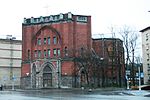Yelizarovskaya
Railway stations in Russia opened in 1970Railway stations located underground in RussiaRussian railway station stubsRussian rapid transit stubsSaint Petersburg Metro stations

Yelizarovskaya (Russian: Елиза́ровская) is a station on the Nevsko–Vasileostrovskaya Line of Saint Petersburg Metro, opened on December 21, 1970.
Excerpt from the Wikipedia article Yelizarovskaya (License: CC BY-SA 3.0, Authors, Images).Yelizarovskaya
Babushkina Street, Saint Petersburg Smolenskoe
Geographical coordinates (GPS) Address Nearby Places Show on map
Geographical coordinates (GPS)
| Latitude | Longitude |
|---|---|
| N 59.8967 ° | E 30.4235 ° |
Address
Babushkina Street 10
192029 Saint Petersburg, Smolenskoe
Saint Petersburg, Russia
Open on Google Maps









